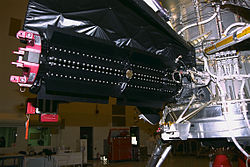Cassini-Huygens
Cassini-Huygens is a joint project of NASA, ESA and the Italian Space Agency. An unmanned space mission is to explore the whole Saturnian system with the smallest possible detail, exploring the atmosphere, the interior structure, the surrounding moons, its amazing rings and its magnetic field. A four-year mission took place on 26 April 2017 successfully.
The mission comes after NASA missions to Voyager 1 and Voyager 2, which were made during 1977-1980 and produced accurate images of the planets and their moons (read Voyager 1). The Cassini-Huygens mission differs from its predecessors in the determination here to drop Higgins on the surface of Saturn's Titan moon in parachutes to study its atmosphere and surface. But this does not mean that Voyager's mission, unlike their planned ones, is still working and sending the results of their observations so far (2010) on their way to explore the edge of the solar system, about 130 astronomical units.
In December 2004, the Cassini-Huygens spacecraft reached the planet Saturn after cutting 3.5 billion kilometers and completing its approach to Titan. Hoygens separated from the mother spacecraft and made its way toward Saturn. The probe began quietly heading toward the moon Titan since its departure from the Cassini spacecraft on December 24, 2004. The Cassini will remain in Saturn until 2008 for the exploration of Saturn's rings and moons.
Cassini's mission has taken many times to keep his spin on Saturn and explore its rings and moons. The mission of the Cassini probe ended on September 15, 2017 by inserting it into Saturn's atmosphere and burning it at a very high temperature. [2] [3] In order to avoid the risk of biological contamination of any Saturn moons that have active environments and are likely to be viable.
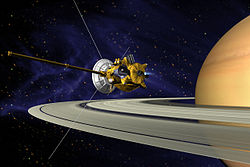
the journey
The space flight began in 1997 after the European Space Agency (ESA) successfully created the Hoygens probe and launched it in cooperation with NASA on its Cassini spacecraft. In December 2004, the ship reached Saturn's orbit after cutting 3.5 billion kilometers and completing its approach to the Titan. Hoygens separated from the mother ship and made its way toward the moon, and Hoygens began moving quietly toward the moon Titan since his departure from the Cassini spacecraft On December 24, 2004. The Cassini will remain in Saturn until 2008 for research purposes. The probe, which takes the shape of a small bird dish, weighs about 340 kilograms and today penetrates the dense atmosphere of the moon at speeds of up to 21,000 km / h. Then its speed is curbed by three umbrellas that open continuously until it reaches a speed of 45 km / h.
The probe took pictures on June 6, 2009, of the Titan's northern pole, showing day and night in the northern half of Saturn's largest moon, using blue, red and green spectral filters all mixed to create the natural colors visible in the image. The probe was about 194 km from the planet when it took pictures at a scale of 11 km per pixel. [6] These data showed that the moon Titan is a mountain titris, sand dunes, many lakes, and possibly volcanoes, which in turn make it very close to Earth
Equipment [edit]
The Titan 4B carries the Cassini-Higgins probe on the platform.
The Cassini probe carries six special measuring devices, which capture images and collect data on pressure, temperature and the nature of organic chemical reactions. It is equipped with radar radar and visible light, an infrared radiometer, a cosmic dust analyzer, a plasma spectrometer and an ultraviolet spectrometer. Magnetometer and mass spectrometer.
Cassini contains an antenna to connect to the Earth and to observe the atmosphere of Saturn Saturn and to measure the gravitational field of the moon and Saturn. The probe transmits the information it collected to the mother ship Higgins, which in turn sends it to earth to reach Darmstadt, 67 minutes after it was sent.
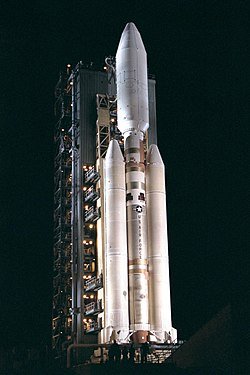
Mission cost
NASA announced the cost of the Cassini-Higgins mission to the planet Saturn as follows: [9]:
Development before departure: $ 1,422 billion
Mission consolidation: $ 710 million
Follow-up to the mission: $ 54 million
Takeoff: $ 442 million
ESA expenses: $ 500 million (of which € 120 million is from Germany) [10]
ASI Italy expenses: $ 160 million
Total cost: $ 3,288 billion
Track to Saturn
The course of the Cassini-Higgins probe to Saturn (departure September 15, 1997 traffic by Jupiter December 30, 2000 and access to Saturn on July 1, 2004.)
The Cassini-Huygens probe took off at the top of a Titan 4B rocket on September 15, 1997 from the Kennedy Space Center in Cape Canaveral. At the top of the Titat 4B rocket was the upper stage Centaur, which carried the probe and gave the probe a speed of 8 km per second and directed it on an initial path to Venus. The initial path was chosen for Venus as the missile could not speed up the probe at a velocity of 1 and 15 kilometers per second to reach Saturn (at that time Titan 4B was the strongest rocket). [11]
According to the plan, the probe travels through two cycles around the sun and Venus, giving it a gravitational pull. The first batch was in April 1998 and the second in June 1999, during which the probe speed increased from 8 km / s to 6 to 13 km / s. Before heading to the outer planets, the probe moved on August 18, 1999 to Earth, which was also propelled by a 19-km / 2-inch gravitational pull of gravity and directed to Jupiter.
During that first phase of the expedition, the high gain antenna (in the form of the dish) was directed to the sun to protect the probe from radiation. On January 23, 2000, an approach was reached to convict 2685 Masurzky
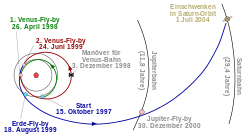
Traffic to the buyer
Buyer's image.
After passing the ground, Cassini marched in a way to the buyer of the largest solar system. On 1 October 2000 Cassini photographed the buyer from 3 to 84 million kilometers. [11]
In the next 5 months, Cassini was able to record his scenes from the buyer and his moons and complete what he had done by the Galileo probe.
Cassini photographed the buyer's high definition, total images 26,287, and was able to photograph using filters to collect information on the distribution of gases in Jupiter's atmosphere. [11]
During December, Cassini had the opportunity to photograph some Jupiter moons. Because the distance between Cassini and between 4 and 4 km appeared small. However, it was possible to analyze the images and assign one of them to a rectangular scale (120 km x 150 km) [11]
The magnetic imaging device measured the buyer's magnetic field in three dimensions. On March 22, the buyer's observations ended and Cassini continued his route to Saturn as the main mission.
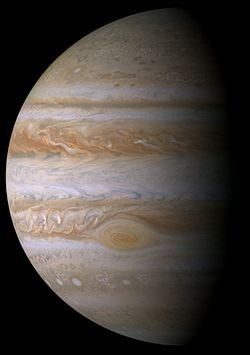
Nuclear fuel supplies Cassini power
Due to Saturn's distance from the sun, solar panels do not suffice to extend Cassini power. For this reason, three nuclear batteries are used for thermal and electrical energy required to operate their devices.
Each battery contains 2 and 12 kg of plutonium oxide, including 7 and 9 kg plutonium-238. Plutonium-238 is heated by its radiant power as it radiates alpha rays. Each battery produces 4400 watts of heat. [12] Part of that thermal energy is converted to electrical energy by a thermocouple of 7% efficiency. [13]
The output of one battery at the start of the flight is 285 watts (ie the three batteries produce 855 watts) of electricity. This energy is reduced by plutonium-238 radiation over time (half life: 83 years), equivalent to 1 and 3% per year [12]. The batteries produced 670 watts of power in 2010, and at the end of the mission in 2017, the resulting electricity will reach about 605 watts
